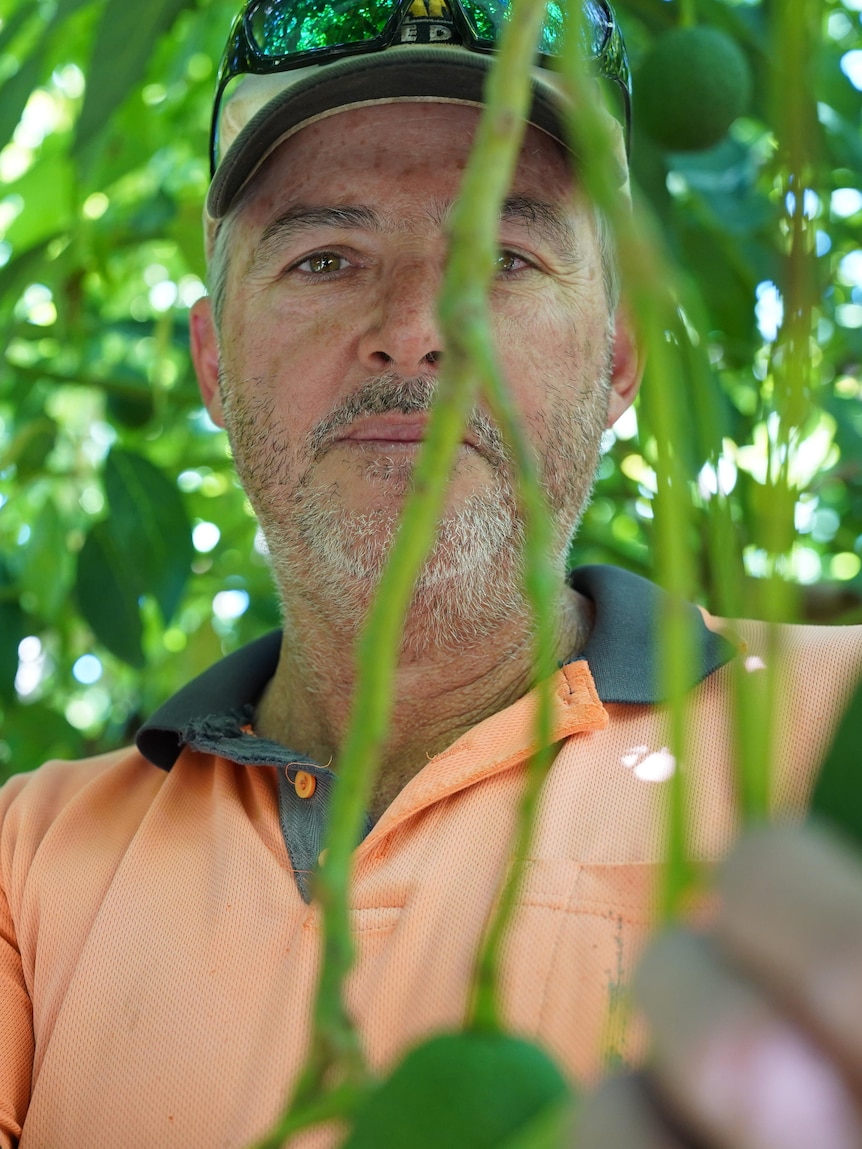Australian avocado farmers who have battled low prices and gluts in recent years are setting their sights on lucrative export markets.
Despite the industry dealing with oversupply, some farmers are planting more trees as global demand for avocados continues to grow.
Among them is Riverland avocado farmer Justin Loffler, who recently planted more than 600 new trees.
Justin Loffler sees opportunity in the future of Australia’s avocado industry. (ABC News: Will Hunter)
“Despite what people are calling a domestic glut, I think there’s still a positive future for the avocado industry both in Australia and utilising the export markets,” he said.
“We need to keep developing those markets to make sure we can sell avocados without going crazy on the planting.”
He said while most of his produce went to domestic markets, he thought export markets were critical.
“We can take excess fruit off the Australian market and make sure that everyone can get a decent return,” he said.
Some growers are planting new trees expected to bear fruit in three to four years. (ABC News: Will Hunter)
Production is set to keep rising for the next five years as new plantings across the country start to bear fruit.
Avocados Australia’s latest data shows export volumes have increased by 600 per cent in the past three years to 21,979 tonnes, rising to almost 15 per cent of Australia’s total production.
But with another record-breaking 150,912 tonnes of avocados grown this year, Avocados Australia chief executive John Tyas said the industry needed to further increase exports.
New avocado trees have been planted at Mr Loffler’s farm in the Riverland. (ABC News: Will Hunter)
Global demand for avocados
Forecasted to be the most traded tropical fruit across the world by 2030, global demand for avocados continues to grow.
With the latest export market to India worth millions of dollars opening up to Australian growers, Mr Tyas said they were working on getting access to the Chinese market next.
A record-breaking number of avocados have been grown in Australia this year. (ABC News: Will Hunter)
“It’s now the largest avocado market in Asia. We think there’s great potential in that market for us,” he said.
“We’re very hopeful that we’ll be the next product that will be on the table for negotiation and we’ve been doing everything we possibly can to secure that position.”
Avocado exporter chief executive at the Avolution, Anthony Allen, said new trees were also being planted in Western Australia and Victoria as global demand continued to rise.
While Australians eat close to 5 kilograms of avocados per person a year, Asia’s consumption per capita currently still sits below 1kg.
Justin Loeffler wants to see export opportunities for Australian-grown avocados continue to expand. (ABC News: Will Hunter)
“So when you’ve got a world that hasn’t all been able to experience that yet, you’re going to have strong growth,” Mr Allen said.
“India and China, they’re like a few minutes into the experience.”
Australians eat almost five kilograms of avocados per person per year. (ABC News: Will Hunter)
Growers consider exiting industry
But not all growers are ready to invest in a larger crop.
Far North Queensland’s Atherton Tablelands is one of Australia’s major avocado-producing regions, growing both Hass and Shepard avocado varieties.
Joe Moro says avocado farmers in the north are interested in new export markets. (ABC News: Brendan Mounter)
FNQ Growers chair Joe Moro said farmers in the region were pulling out older trees as lower prices and increasing production costs made them unviable.
“People are pulling out unproductive blocks and re-evaluating their position,” he said.
“They’re still looking at their options on an alternative tree planting for the future.”
In recent years, the rapid growth has outweighed consumer demand with the check-out price dropping as low as $1 per piece.
Some Far North Queensland farmers have dumped excess fruit. (Supplied: Jan De Lai)
It has made it challenging for some Atherton Tablelands farmers to recoup their costs.
Mr Moro said while they welcomed export opportunities they wanted to see more “good signs” the fruit had become profitable before any crop expansions.
Affordable avos
Rabobank analyst Pia Piggott said growing export markets was essential to regaining profitable price levels for growers.
Pia Piggott says avocado prices for Australian consumers are expected to remain low for some time. (Supplied: Rabobank)
“It’s quite a difficult industry to be in and prices aren’t very positive and profitable for a lot of growers,” she said.
She said prices were expected to remain volatile in Australia for some time, with supply of avocados fluctuating throughout the year.
Source : ABC News (AU)


